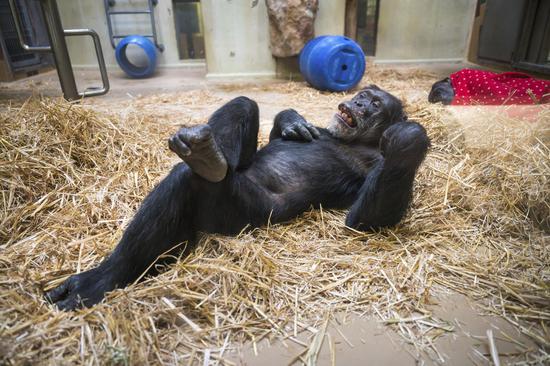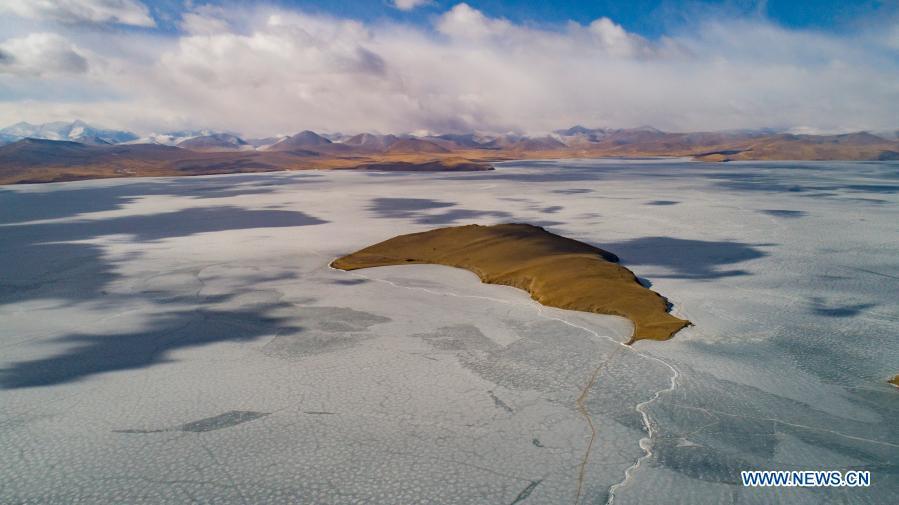
Aerial photo taken on March 6, 2021 shows an island on the frozen Puma Yumco Lake, southwest China's Tibet Autonomous Region. In the coldest time every year, at Dowa village, 5,070 meters above sea level, thousands of sheep are taken across frozen water to islands on Puma Yumco Lake, one of the world's highest lakes. Herders usually spend a month with the animals on the islands, where grass grows to waist height. When spring draws near, the herds of sheep will be taken back to their former habitat, by walking across the frozen lake again before the melting of the ice. Such herding practices have lasted for a thousand years at Dowa village. (Xinhua/Sun Fei)
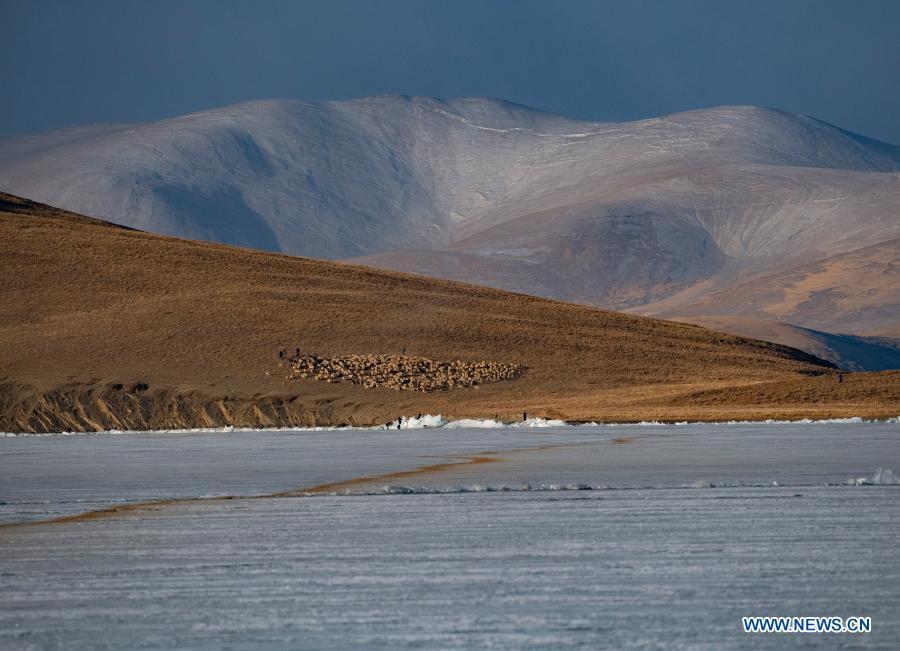
A herd of sheep are led to leave an island on the frozen Puma Yumco Lake, southwest China's Tibet Autonomous Region, March 6, 2021. In the coldest time every year, at Dowa village, 5,070 meters above sea level, thousands of sheep are taken across frozen water to islands on Puma Yumco Lake, one of the world's highest lakes. Herders usually spend a month with the animals on the islands, where grass grows to waist height. When spring draws near, the herds of sheep will be taken back to their former habitat, by walking across the frozen lake again before the melting of the ice. Such herding practices have lasted for a thousand years at Dowa village. (Xinhua/Purbu Zhaxi)

Aerial photo taken on March 6, 2021 shows a herd of sheep walking along a safe path on the frozen Puma Yumco Lake during their annual migration in southwest China's Tibet Autonomous Region. In the coldest time every year, at Dowa village, 5,070 meters above sea level, thousands of sheep are taken across frozen water to islands on Puma Yumco Lake, one of the world's highest lakes. Herders usually spend a month with the animals on the islands, where grass grows to waist height. When spring draws near, the herds of sheep will be taken back to their former habitat, by walking across the frozen lake again before the melting of the ice. Such herding practices have lasted for a thousand years at Dowa village. (Xinhua/Purbu Zhaxi)
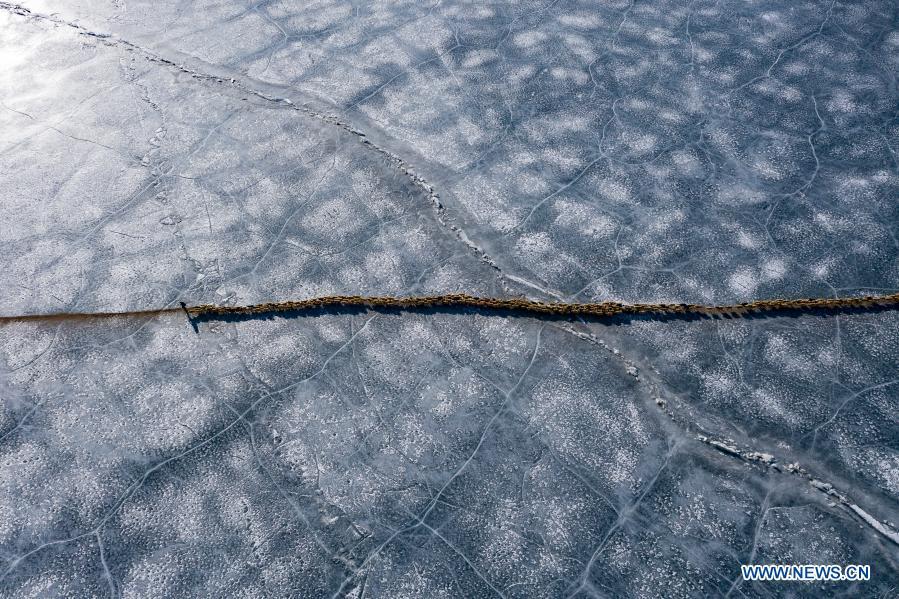
Aerial photo taken on March 6, 2021 shows a herd of sheep walking along a safe path on the frozen Puma Yumco Lake during their annual migration in southwest China's Tibet Autonomous Region. In the coldest time every year, at Dowa village, 5,070 meters above sea level, thousands of sheep are taken across frozen water to islands on Puma Yumco Lake, one of the world's highest lakes. Herders usually spend a month with the animals on the islands, where grass grows to waist height. When spring draws near, the herds of sheep will be taken back to their former habitat, by walking across the frozen lake again before the melting of the ice. Such herding practices have lasted for a thousand years at Dowa village. (Xinhua/Purbu Zhaxi)
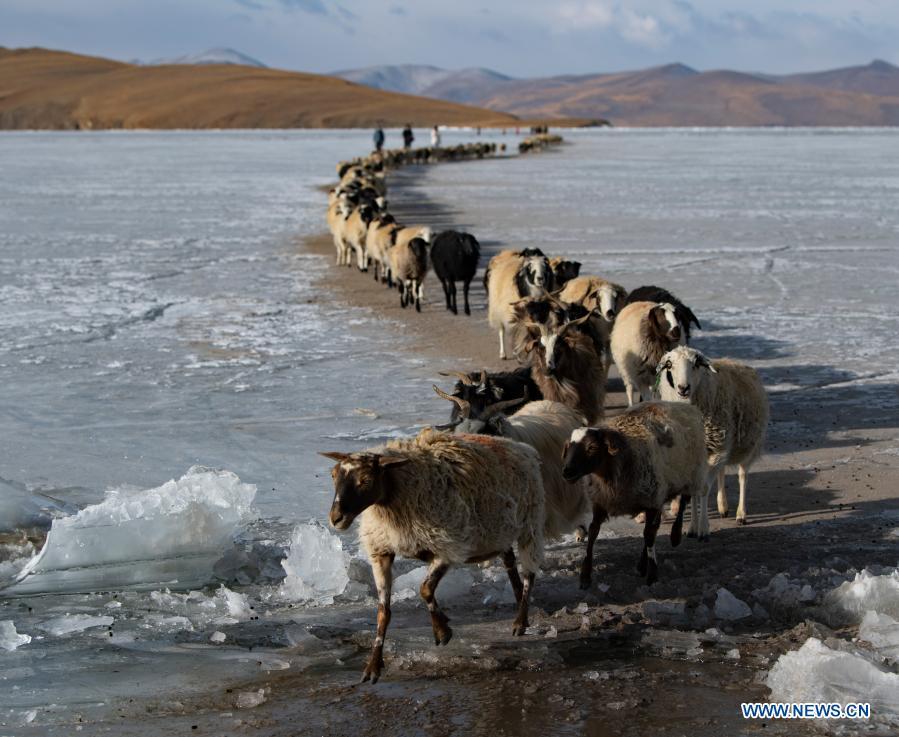
Photo taken on March 6, 2021 shows a herd of sheep walking along a safe path on the frozen Puma Yumco Lake during their annual migration in southwest China's Tibet Autonomous Region. In the coldest time every year, at Dowa village, 5,070 meters above sea level, thousands of sheep are taken across frozen water to islands on Puma Yumco Lake, one of the world's highest lakes. Herders usually spend a month with the animals on the islands, where grass grows to waist height. When spring draws near, the herds of sheep will be taken back to their former habitat, by walking across the frozen lake again before the melting of the ice. Such herding practices have lasted for a thousand years at Dowa village. (Xinhua/Sun Ruibo)
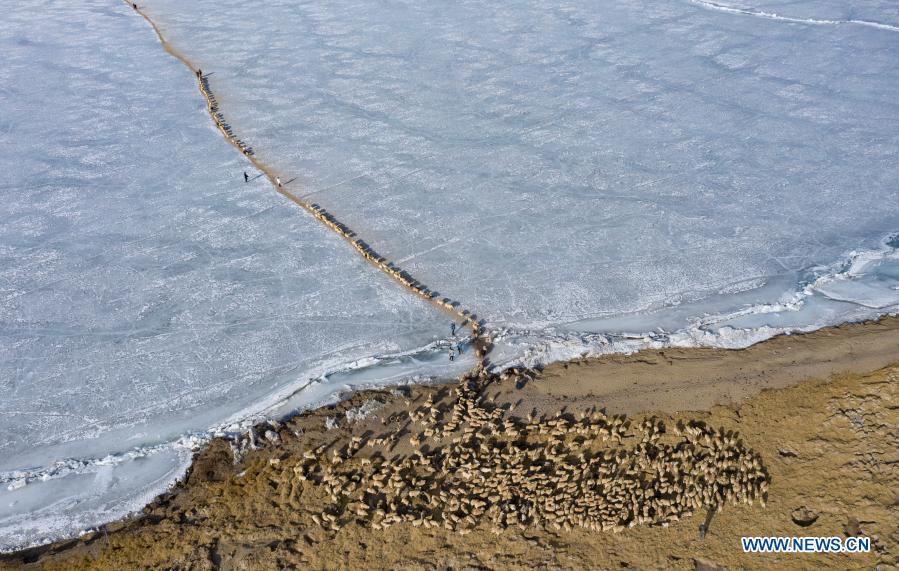
Aerial photo taken on March 6, 2021 shows a herd of sheep walking along a safe path on the frozen Puma Yumco Lake during their annual migration in southwest China's Tibet Autonomous Region. In the coldest time every year, at Dowa village, 5,070 meters above sea level, thousands of sheep are taken across frozen water to islands on Puma Yumco Lake, one of the world's highest lakes. Herders usually spend a month with the animals on the islands, where grass grows to waist height. When spring draws near, the herds of sheep will be taken back to their former habitat, by walking across the frozen lake again before the melting of the ice. Such herding practices have lasted for a thousand years at Dowa village. (Xinhua/Purbu Zhaxi)
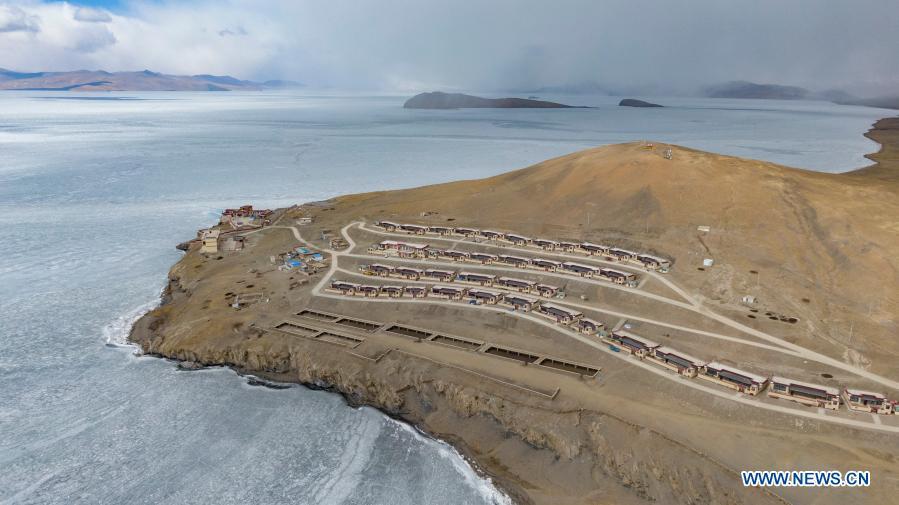
Aerial photo taken on March 6, 2021 shows a view of Dowa village in Nakartse County, southwest China's Tibet Autonomous Region. In the coldest time every year, at Dowa village, 5,070 meters above sea level, thousands of sheep are taken across frozen water to islands on Puma Yumco Lake, one of the world's highest lakes. Herders usually spend a month with the animals on the islands, where grass grows to waist height. When spring draws near, the herds of sheep will be taken back to their former habitat, by walking across the frozen lake again before the melting of the ice. Such herding practices have lasted for a thousand years at Dowa village. (Xinhua/Jigme Dorje)
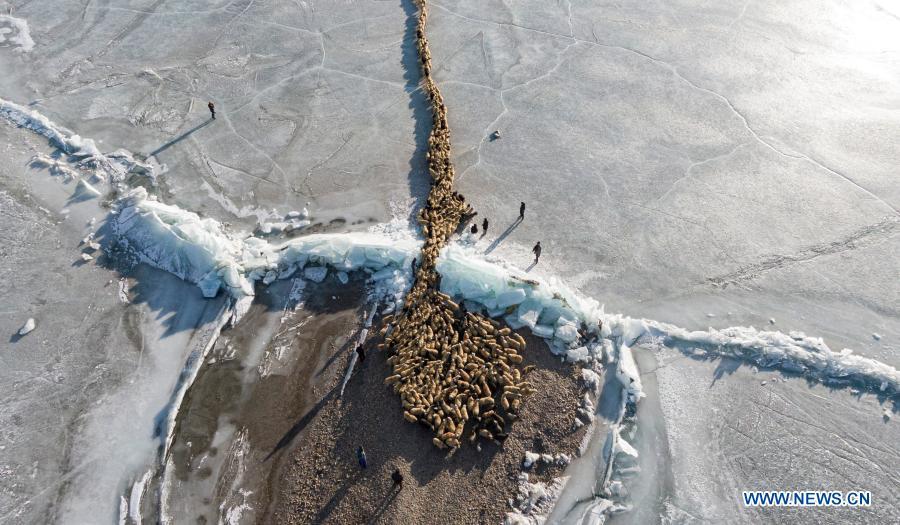
Aerial photo taken on March 6, 2021 shows a herd of sheep walking along a safe path on the frozen Puma Yumco Lake during their annual migration in southwest China's Tibet Autonomous Region. In the coldest time every year, at Dowa village, 5,070 meters above sea level, thousands of sheep are taken across frozen water to islands on Puma Yumco Lake, one of the world's highest lakes. Herders usually spend a month with the animals on the islands, where grass grows to waist height. When spring draws near, the herds of sheep will be taken back to their former habitat, by walking across the frozen lake again before the melting of the ice. Such herding practices have lasted for a thousand years at Dowa village. (Xinhua/Jigme Dorje)
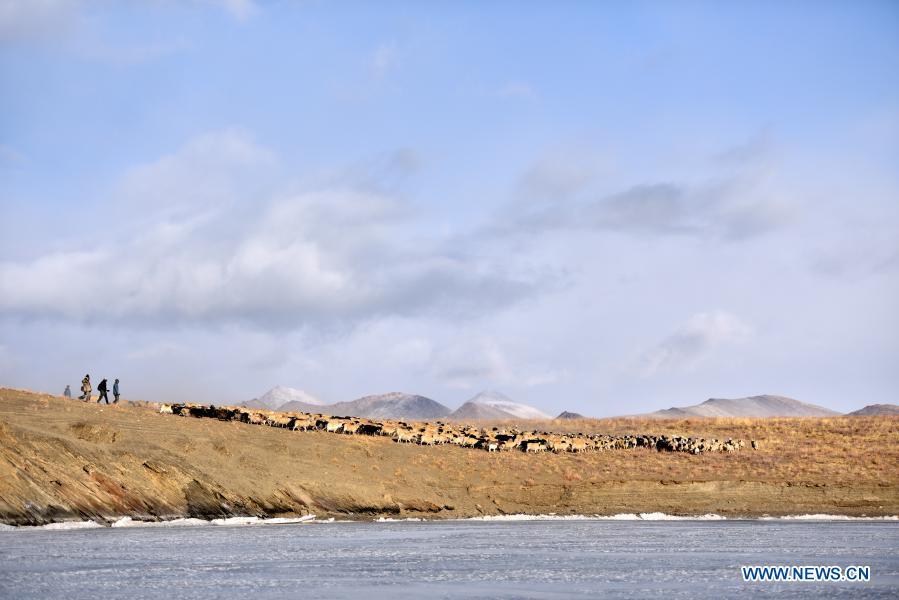
A herd of sheep are led to leave an island on the frozen Puma Yumco Lake, southwest China's Tibet Autonomous Region, March 6, 2021. In the coldest time every year, at Dowa village, 5,070 meters above sea level, thousands of sheep are taken across frozen water to islands on Puma Yumco Lake, one of the world's highest lakes. Herders usually spend a month with the animals on the islands, where grass grows to waist height. When spring draws near, the herds of sheep will be taken back to their former habitat, by walking across the frozen lake again before the melting of the ice. Such herding practices have lasted for a thousand years at Dowa village. (Xinhua/Sun Ruibo)
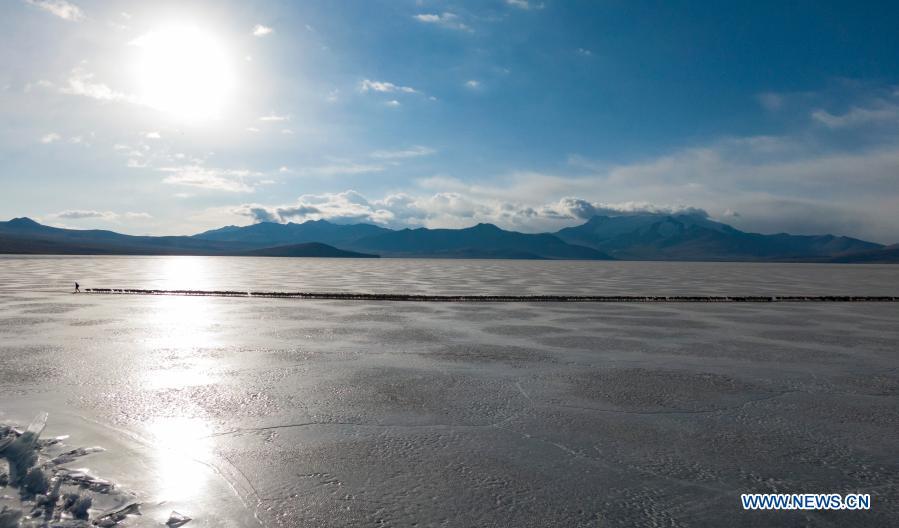
Aerial photo taken on March 6, 2021 shows a herd of sheep walking along a safe path on the frozen Puma Yumco Lake during their annual migration in southwest China's Tibet Autonomous Region. In the coldest time every year, at Dowa village, 5,070 meters above sea level, thousands of sheep are taken across frozen water to islands on Puma Yumco Lake, one of the world's highest lakes. Herders usually spend a month with the animals on the islands, where grass grows to waist height. When spring draws near, the herds of sheep will be taken back to their former habitat, by walking across the frozen lake again before the melting of the ice. Such herding practices have lasted for a thousand years at Dowa village. (Xinhua/Sun Fei)
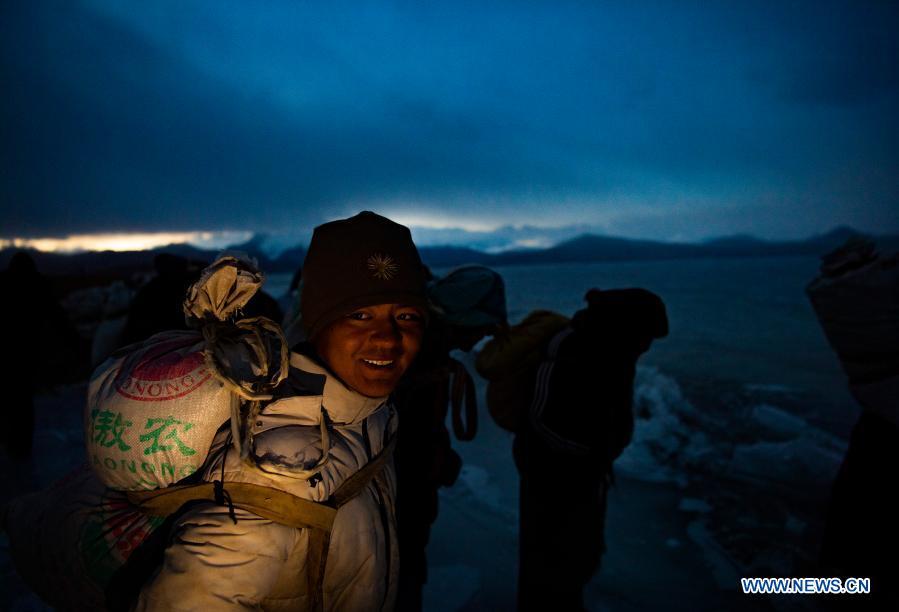
Villagers prepare to spread cow dung and stove ashes to make a safe path on the frozen Puma Yumco Lake, southwest China's Tibet Autonomous Region, March 6, 2021. In the coldest time every year, at Dowa village, 5,070 meters above sea level, thousands of sheep are taken across frozen water to islands on Puma Yumco Lake, one of the world's highest lakes. Herders usually spend a month with the animals on the islands, where grass grows to waist height. When spring draws near, the herds of sheep will be taken back to their former habitat, by walking across the frozen lake again before the melting of the ice. Such herding practices have lasted for a thousand years at Dowa village. (Xinhua/Sun Fei)













